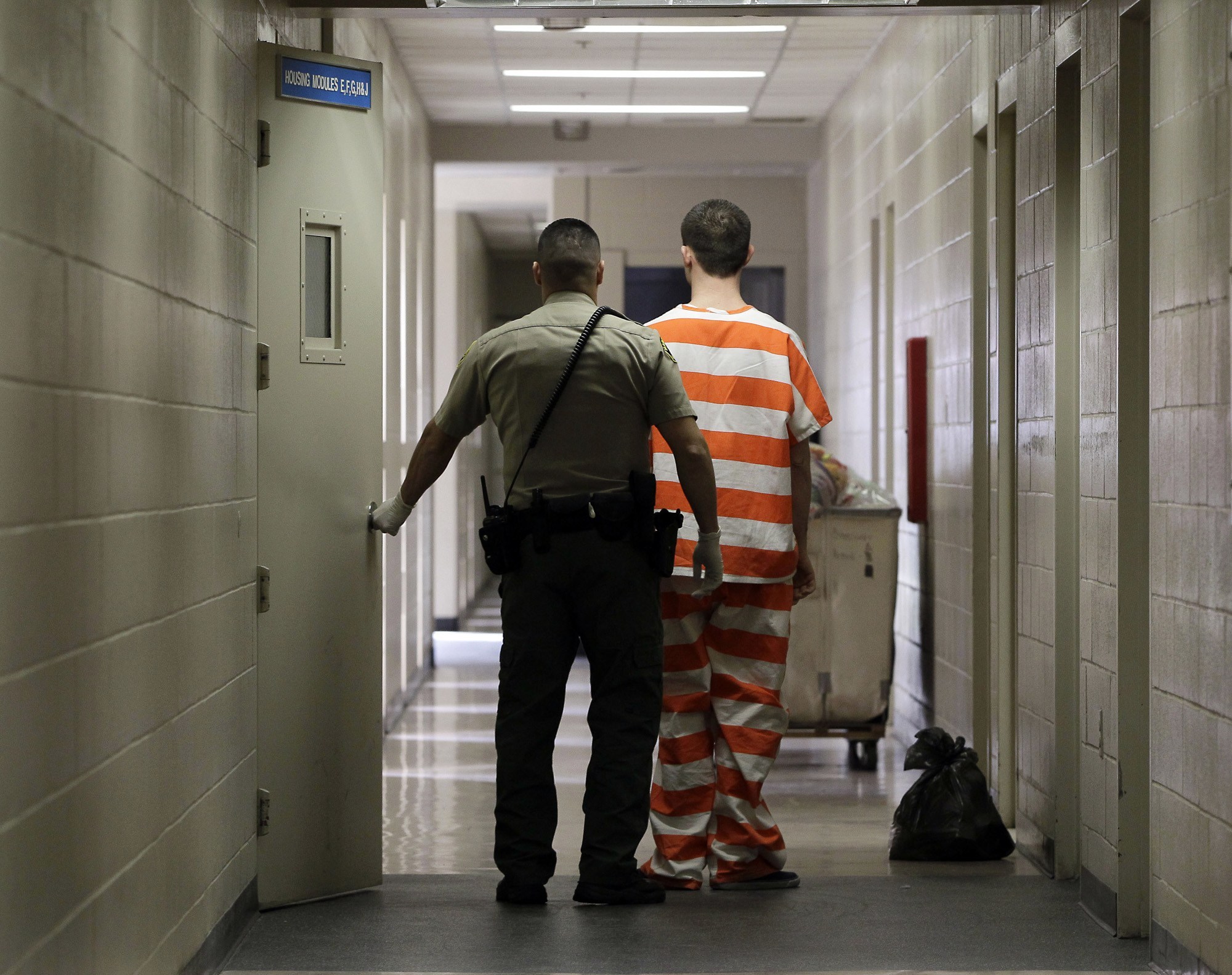Pandemic slows legal voting from California jails

FILE – In this Feb. 21, 2013 file photo, an inmate at the Madera County Jail is taken to a housing unit at the facility in Madera, Calif. The Board of State and County Corrections voted Thursday, Feb. 16, 2017, to require that future jails include space for face-to-face visit. The new regulation applies only to future jails not under construction. (AP Photo/Rich Pedroncelli, File)
OCTOBER 30, 2020
Jose Armendariz, 30, has never been able to vote.
Sentenced to 90 years to life in prison at 16, Armendariz is barred from casting a ballot by California’s felony disenfranchisement laws.

But after learning that many of those behind bars can cast ballots, he has become an inside organizer for Unlock the Vote, an American Civil Liberties Union project aimed at registering voters in Southern California jails. Armendariz goes cell-to-cell at Orange County’s Theo Lacy Jail, educating people about their eligibility and helping them request a mail-in ballot.
“It’s crazy how many people are either misinformed or not informed at all of their rights,” Armendariz said. “Because that right is one that I don’t have, not having it made me understand how powerful and how valuable and how important it is.”
Tens of thousands of people incarcerated in county jails are eligible to vote under California law, but many will not cast ballots this election, according to Daisy Ramirez, Jails Conditions and Policy Coordinator at the ACLU of Southern California. Some are not aware they can vote or are misinformed about their eligibility, while others who are registered haven’t received a ballot because of jail mail delays. This year, the pandemic has complicated efforts to overcome those barriers. Advocates who typically would enter jails to help potential voters have not been given access.
“Most people in county jails can vote,” said Brittany Stonesifer, voting rights attorney at the ACLU of Northern California. “That includes anyone who’s awaiting trial for any crime, anyone who is in county jail for a misdemeanor, anyone who is in county jail” for certain felonies as dictated by state law.
Almost 61,000 people are incarcerated in county jails across the state, according to California’s Board of State and Community Corrections. The agency does not track how many of those people are eligible to vote. But in California, in addition to those cited by Stonesifer, people on probation and other forms of community supervision in and out of jails — excluding parole — are also eligible to vote.
People like Armendariz serving a state prison sentence inside a county jail, people who have been convicted of a felony and are awaiting transfer to a state prison, or people who have been incarcerated for violating parole are prohibited from voting.
But restrictions for those on parole might soon change. Proposition 17, if passed by California voters this election, would change the state constitution to also allow people on parole to vote.
For those who are eligible to vote, registering requires time and patience. First, they need to request a registration form with an administrator in their unit. Depending on the county and the facility, people can do that by paper registration form or online. Dean White, Programs Supervisor at Alameda County Santa Rita Jail, said that most people incarcerated in Santa Rita have access to tablets, which they can use to request a registration form.
Then, they need to register to vote by mail, using the jail’s address as their mailing address. Once they are registered, their ballot will be sent to the county jail. Even then, there is no guarantee they will receive a ballot.
“Mail issues are a constant theme for people that are in custody,” Ramirez said.
Armendariz said he’s noticed an even greater delay with election-related mail.
“We’re not getting the mail ’til about five, seven days later, and sometimes I’ve seen guys that don’t get mail ’til like 10 days after it’s been postmarked by the United States Postal Service.”
Some of those Armendariz has helped register to vote have not received their ballots, he said. And with the clock ticking down to election day, the risk is that voters on the inside won’t get their ballots mailed in time. Ramirez and Armendariz are encouraging voters to complete and mail their ballots as soon as possible to ensure their votes get counted.
Jails closed to advocates during pandemic
Before the pandemic, outside organizations like Unlock the Vote, the Alameda County Public Defender’s voter outreach program VOICE, and All of Us or None provided voter education to people behind bars across the state. But now those groups are relying on people like Armendariz to spread their message.
He said he’s determined to educate qualified voters in Theo Lacy about local ballot measures, propositions, and candidates.
“The right to vote means to be a part of a community again, to not be an outcast, to have the freedom and liberties that the constitution promises us,” Armendariz said. “Through them, I feel like I’m also exercising my right to vote, even though I don’t have it.”
Angelique Evans of All of Us or None in Los Angeles worked prior to the pandemic to register people to vote at local county jails. “I’m a formerly incarcerated person that loves my people, you know?”
But, “because of COVID, now everything has been put to a halt,” Evans said.
Longtime relationships with people inside have helped. In phone calls from jail contacts, Evans learned some potential voters were not receiving their ballots when expected. Those inside the facility also said they hadn’t had the usual access to television news or newspapers, which help with voting.
“They don’t have access to what’s going on outside,” Evans said.
The Los Angeles County sheriff’s department did not respond to a request for comment. The county posts information on how to vote from jail on its website.
Before the pandemic, Robert Ortiz Archila hosted workshops inside Los Angeles’ Men’s Central Jail on applying for college and on state ballot propositions. The pandemic changed things.
“During COVID, everything pretty much stopped,” said Ortiz Archila, Outreach Coordinator for Project Rebound’s California State University, Los Angeles branch.
The workshops were used, he said “to make them aware of what’s going on… We want to make them aware of policy, of law, of what they need to transition into higher education.”
In Sacramento County, Henry Ortiz said he hasn’t been able to do his regular civic engagement workshops inside county facilities for similar reasons. The senior staff organizer with All of Us or None – Sacramento finds that unfair.
“Everything is restricted now,” he said. “This is a crucial time, one of the most controversial elections of our time. We need as much participation as we can.”
In turn, advocates at All of Us or None have resorted to mailing in letters and using their own newspapers and even YouTube videos and podcasts to engage those inside.
Some counties held up as models
Protima Pandey used persuasion and crafty video work to thwart pandemic restrictions.
Pandey leads the Office of Women’s Policy in Santa Clara County. Before the pandemic, her team had been visiting the Elmwood Complex Women’s Facility twice a month to evaluate the women’s needs. In 2018 the county, working with the League of Women Voters, registered 82 of the jailed women to vote.
This year’s pandemic initially stopped all outside programs, but that changed due to a collaboration between her office, jail leadership and rehabilitation officers, the county registrar, the Commission on the Status of Women and the League of Women Voters.
Pandey said the team approach led to cooperation from the sheriff’s department when she asked to regain access to the jail for voter registration. “They understood that this was a need, given the fact that elections were going to happen, given the fact that presidential elections happen only once in four years,” she said.
The multi-agency group produced a video on voting rights in jails that was streamed in common areas of all three of the county’s jails. Then it received permission to hold in-person socially-distanced workshops. Dozens of jailed people showed up to the workshops, some with ballots in their hands and questions on their mind.
“Now that you educated them about their rights, they have more questions,” Pandey said.
At a workshop last week, she helped register 133 women. At the men’s jail, she said, about 100 registered to vote.
Advocates look to Santa Clara County and neighboring Alameda County as models of what counties can do to ensure enfranchisement of those inside. Outside California, they also point to Cook County Jail in Chicago, which will have in-person voting.
In Alameda County, the Public Defender’s Voting Outreach Increases Community Empowerment Program created an online step-by-step voting guide. Sascha Atkins-Loria, co-founder of VOICE, said most of the people incarcerated in Santa Rita have limited access to tablets, where they can view the voting guide and educational materials about local ballot measures.
They, too, have resorted to videos in English and Spanish to engage people behind bars during the pandemic.
“There are only certain situations under which you lose your right to vote and being in county jail, for the most part, isn’t one of them,” Pandey said.
“I am a system partner and it is my job to ensure that the system works.”
Isabella Fertel is a reporter at UC Berkeley’s Graduate School of Journalism.


